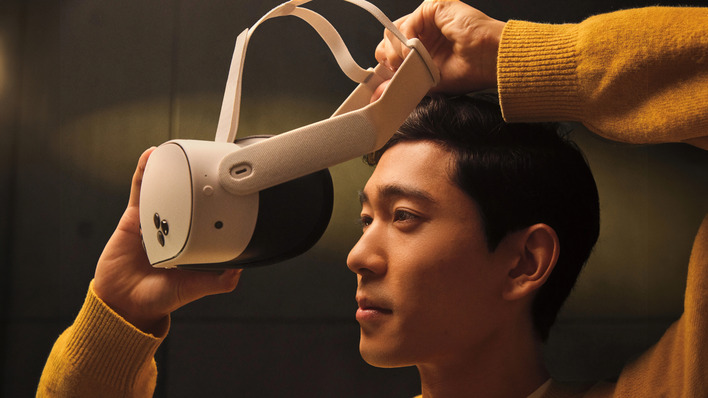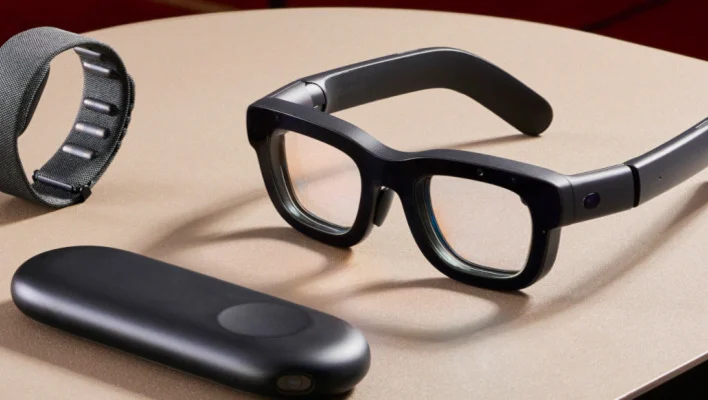Meta debuted its latest offerings for virtual and augmented reality at its Connect event. It finally took the wrap off the AR glasses it has been working on for the last five years, named Orion, which the company says are “the most advanced pair of AR glasses ever made.” Meanwhile, the Meta Quest 3S is will now be an option for buyers looking to jump into VR at a lower price that starts at $299 for the 128GB model and $399 for the 256GB model.
The company says the Quest 3S will provide “the same mixed reality capabilities and fast performance as Meta Quest 3.” It achieves this by having the same Snapdragon XR2 Gen2 SoC inside the headset with the same amount of memory as the higher end option. However, cuts were made to this device’s display, which has a lower resolution (1832 x 1920), only two refresh rate options (90Hz/120Hz), and a lower FOV (96 horizontal / 90 vertical) compared to the full-fledged Quest 3.
Orion looks to be the next evolution of the efforts Meta has undertaken alongside Ray-Ban, which have made it easier to have hands-free interactions with Meta’s AI and services. However, these glasses still don’t deliver anywhere near the immersive AR experience that might be possible with Orion.
What makes Orion the next step in AR devices is the inclusion of holographic displays that Meta has been able to miniaturize so that they fit within the limited confinement of the glasses. The company says that Orion will have “the largest field of view in the smallest AR glasses form to date.” It’s thanks to this field of view that users will feel more immersed compared to glasses that have come before.
Unfortunately, these new glasses won’t be widely available. Meta will only be allowing employees and select individuals outside the company to put Orion through its paces. It considers the glasses a “purposeful product prototype,” and will be using the feedback from this set of users to inform what areas of the design and software need more work for the next iteration.
It’s exciting to see Meta continuing to refine its products in the AR and VR space, even as VR has struggled to make any meaningful headway with consumers. Hopefully, in a few years, the company will finally reach the point where its AR devices legitimately look and feel like normal glasses, which will have a better chance of being appealing to most people.
Meta debuted its latest offerings for virtual and augmented reality at its Connect event. It finally took the wrap off the AR glasses it has been working on for the last five years, named Orion, which the company says are “the most advanced pair of AR glasses ever made.” Meanwhile, the Meta Quest 3S is will now be an option for buyers looking to jump into VR at a lower price that starts at $299 for the 128GB model and $399 for the 256GB model.
The company says the Quest 3S will provide “the same mixed reality capabilities and fast performance as Meta Quest 3.” It achieves this by having the same Snapdragon XR2 Gen2 SoC inside the headset with the same amount of memory as the higher end option. However, cuts were made to this device’s display, which has a lower resolution (1832 x 1920), only two refresh rate options (90Hz/120Hz), and a lower FOV (96 horizontal / 90 vertical) compared to the full-fledged Quest 3.
Orion looks to be the next evolution of the efforts Meta has undertaken alongside Ray-Ban, which have made it easier to have hands-free interactions with Meta’s AI and services. However, these glasses still don’t deliver anywhere near the immersive AR experience that might be possible with Orion.
What makes Orion the next step in AR devices is the inclusion of holographic displays that Meta has been able to miniaturize so that they fit within the limited confinement of the glasses. The company says that Orion will have “the largest field of view in the smallest AR glasses form to date.” It’s thanks to this field of view that users will feel more immersed compared to glasses that have come before.
Unfortunately, these new glasses won’t be widely available. Meta will only be allowing employees and select individuals outside the company to put Orion through its paces. It considers the glasses a “purposeful product prototype,” and will be using the feedback from this set of users to inform what areas of the design and software need more work for the next iteration.
It’s exciting to see Meta continuing to refine its products in the AR and VR space, even as VR has struggled to make any meaningful headway with consumers. Hopefully, in a few years, the company will finally reach the point where its AR devices legitimately look and feel like normal glasses, which will have a better chance of being appealing to most people.


